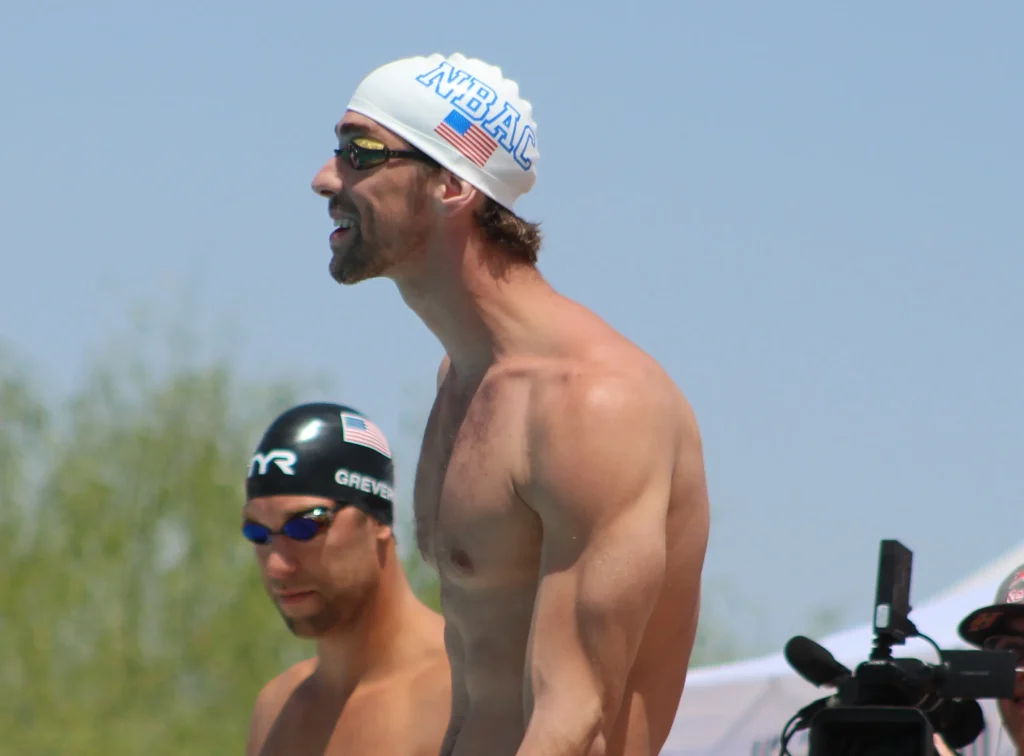In this post we discuss why posture doesn’t matter in the way we’re told it does and the best time to pay attention to it.

Take a look at the image above.
It’s Michael Phelps, the most decorated Olympian of all time perfectly demonstrating forward head posture.
If you visited a clinic with shoulder or neck pain looking like Phelps, I have no doubt your posture would be diagnosed as the source of the issue.
It’s strange therefore that Phelps managed to become one of the greatest athletes of all time with what many would describe as ‘bad posture.’ Let’s dig in.
What is posture?
Posture comes from the Latin word ‘ponere’ which translates as to put.
So the positions you put your joints in is an accurate definition.
Posture doesn’t just refer to your spine and shoulders but rather every joint in your body.
This is interesting because most people I meet with back or shoulder pain think their posture is a factor.
Hardly anybody mentions their posture when looking for foot or knee pain solutions however.
If posture is a factor in the aches and pains of your trunk and upper body, surely it’s a factor in your aches and pains elsewhere too?
We know that placing your joints in extreme positions for long periods of time can cause pain. This is the basis for the stress positions used as part of so called ‘enhanced interrogation techniques.’
Unless you’re unfortunate enough to find yourself in a CIA black site, you’ll probably be able to move yourself out of a position before it becomes painful however.
If you’re not thinking about it, by definition this an unconscious activity. Your central nervous system (CNS) will arrange your joints to minimise the stress on the anatomical structures of your body, maintain maximum stability and minimise energy consumption.
Posture is not solely about these factors however. It’s also related to your mood, your environment and your expectations of what’s to come.
For example, if you’re waiting for a bus you’ll adopt a different posture to somebody who’s about to break into a sprint to catch one.
All of these factors make postural assessments and the conclusions they generally draw somewhat of a nonsense of course.
When does analysing posture become important then?
Whilst analysing posture statically won’t tell you much, Iooking carefully at what happens when you try to move can elicit more useful information.
Say for example your shoulders appear to be in a forward position (think ‘bad posture’). The more relevant question is whether you can move them out of this position.
If you can then this position is a choice and for me is less of a concern. If you can’t then this might present a training opportunity.
Assessing what happens to the positions of your joints when an external force is applied can also provide interesting information.
Take an exercise like a standing bicep curl for example.
Looks simple right? You just bend your elbow and bring the dumbbell towards your shoulder.
Notice how many people bring their shoulder towards the dumbbell at the same time however.
This could be your CNS trying to find an easier route. Or it could be indicative of an inability to control your shoulder.
Try correcting it and if you can’t, it’s probably the second one.
Perhaps the area where posture has the biggest influence is the place where it’s assessed the least, the foot.
To enable efficient motion, your foot must go through a transformation from a mobile structure that is capable of absorbing force, to a rigid one that enables you to propel yourself forwards.
If your foot is held in either of these extremes, you will likely experience issues either at the foot itself or further up the leg.
Summary
The positions you find yourself in when static are something to be aware of. They are not significant enough to base a treatment plan or training programme on however.
What happens when you move is where the gold is. Pay attention to how well the things that should be moving are moving and whether the stuff that should be staying still is in fact doing so.
In those terms every training session should involve postural analysis.
To enable efficient motion, your foot must go through a transformation from a mobile structure that is capable of absorbing force, to a rigid one that enables you to propel yourself forwards. – What’s the function of our knees in this “efficient” motion?
If your foot is held in either of these extremes, you will likely experience issues either at the foot itself or further up the leg.
– Same question, can you elaborate more about how do our knees matter when experience any issues? E.g. knees bent and up difficulties.
Thank you.
Thanks for your comments Sara. Our knees bend to absorb force.
Good article Paul. We have all been to some supposedly good physical therapist who looks at you in a static state and says, your heads too far forward and your shoulders are rounded. Then you do feel like crap. Physical therapy is a dynamic and it is one of the toughest jobs going around , for that reason.